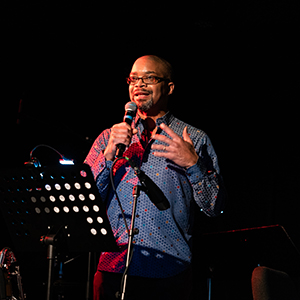Even if you don’t remember the Drake, you’ve probably passed by the graffiti. For decades, two messages in white spray paint on the brick exterior of what’s now Amherst Coffee have expressed a wish that makes either perfect sense or none at all, depending on your era at the College. One reads, “Save the Drake,” the other, “For Willy, for humanity.”
The Drake was a hotel and bar on Amity Street that closed in 1985. Willy (actually Willie) was the bartender. And this matters now because, after more than 35 years, the Drake has been saved.
The second incarnation of the Drake is a live performance and music venue that opened in town last spring, a few blocks away from the original. The new Drake occupies 4,000 square feet on Pleasant Street, in what was most recently the upstairs of the High Horse. With a capacity between 170 and 240, it is managed by the local downtown association as a nonprofit. Most months, it hosts more than a dozen shows and workshops. The opening week, for example, brought rockers Dinosaur Jr. and jazz violinist Regina Carter.

Darryl Harper ’90 is among those who don’t remember the original Drake—it closed the year before he arrived in town as a student. But last semester Harper—now an Amherst professor and jazz clarinetist—chose it as the venue to launch his latest recording. He celebrated the release of Chamber Made, his eighth album, in a November show at the Drake.
Chamber Made considers the porous boundaries between jazz and chamber music. “The album examines who’s allowed to play chamber music, what’s allowed to be called chamber music, who’s allowed to play jazz and what’s allowed to be called jazz,” says Harper, the John William Ward Professor of Music, director of the Center for Humanistic Inquiry and chair of the music department.
Both genres depend upon the relationships cultivated among the performers, he says. He traces his broad interest in “how and why we group ourselves” to his undergraduate years.
When Harper was an Amherst student, the town had nothing like the current Drake. “There are not many live-music venues like this anywhere,” he says. “It’s not a bar that has music; it’s a music venue that has a bar. It’s not a restaurant that has music, or a stadium. It’s intentionally designed as a music venue. This means that the way it’s lit, the way it’s shaped, the way sound is treated—those are all given primary consideration.” The nonprofit business model has meaning too. “It’s saying, We’re a place that brings people together around the experience of live music,” Harper says. “That’s unusual.”
As Harper performed at the Drake, he was gratified to spot in the audience colleagues, friends, family, students and neighbors. “We were sharing an experience together. That is the reason for being for the venue,” he says, “and it’s an important part of what I want to achieve with my work.”
The College is invested in the Drake’s success, in part because it makes the town more vibrant and offers opportunities for music students to perform off campus. The College donated $100,000 to the Drake, and the music department donated a Steinway piano.
The Drake’s winter lineup features another Amherst alum: Tim Eriksen ’88, formerly of Cordelia’s Dad. He is the only musician to have shared the stage with both Kurt Cobain and Doc Watson. Looking ahead to spring, the calendar
includes a UMass Bach festival, an all-women string band and much more.
Photographs by Jessica Scranton
